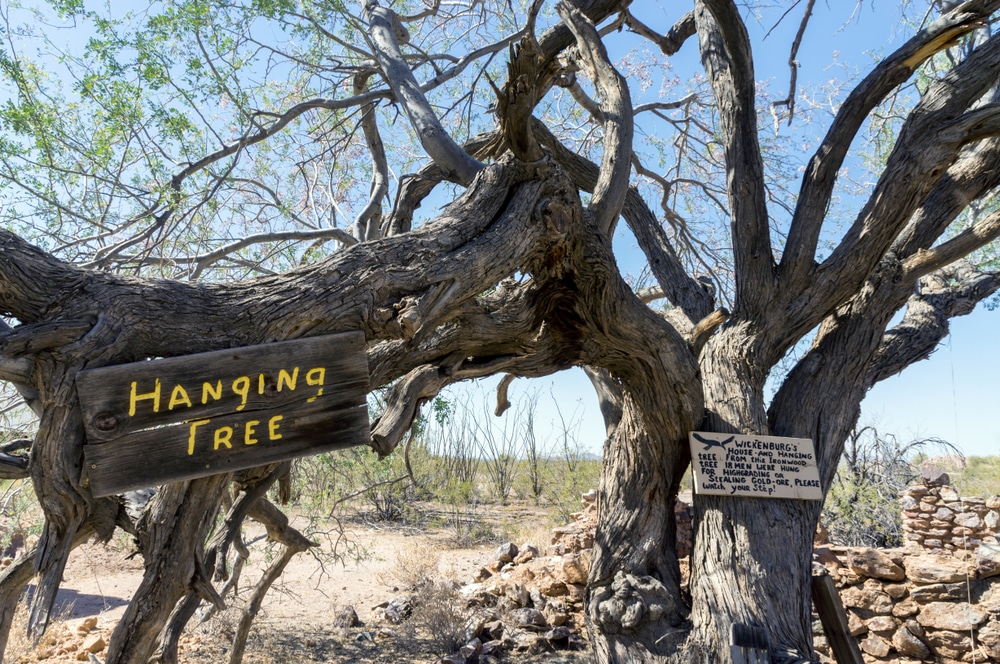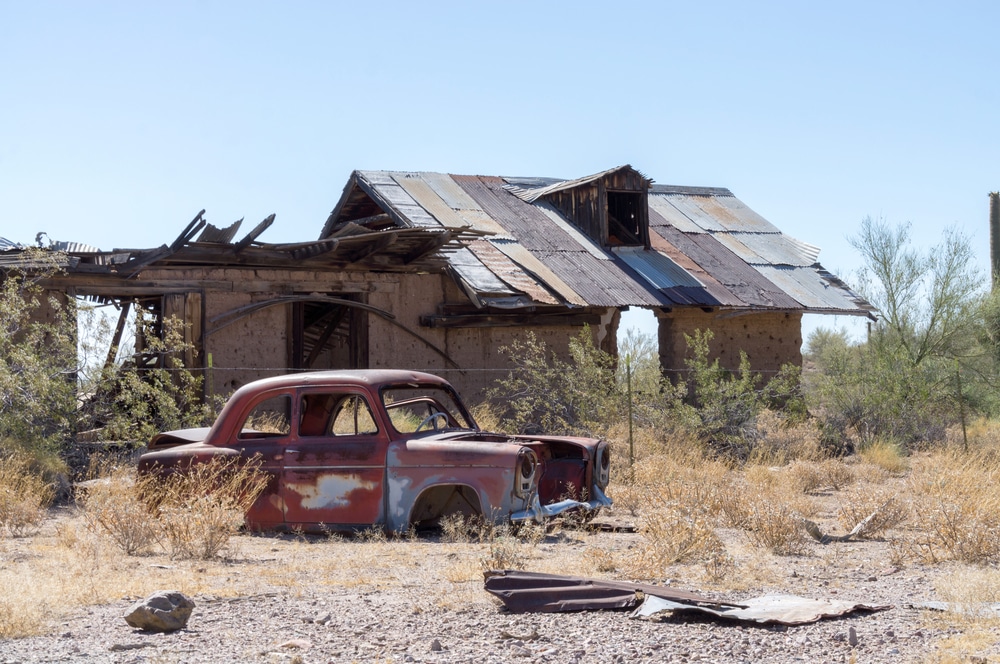The desert wind whispers through the abandoned wooden structures of Vulture City, carrying the ghosts of ambition and forgotten fortunes. Standing amid the sun-bleached ruins, it’s easy to imagine the bustle of miners rushing to their shifts, the clink of glasses in saloons, and the distant thunder of stamp mills crushing ore. Located just 14 miles southwest of present-day Wickenburg in central Arizona, this once-thriving mining settlement now stands as a testament to the boom-and-bust cycle that defined so many Western frontier towns.
Where approximately 5,000 souls once sought their fortunes in the harsh Sonoran Desert, only silent buildings and scattered grave markers remain. The town’s pioneer and community cemeteries, the remnants of its once-vital newspapers, and the traces of railroad connections tell a story of human tenacity in the face of unforgiving elements and economic uncertainty. As we walk through Vulture City today, we tread on ground that witnessed one of Arizona’s most significant gold rushes—a place where pioneer dreams were born, flourished briefly, and ultimately came to rest beneath the watchful eyes of distant vultures circling in the Arizona sky.

The main attraction in Vulture City is its guided walking tour through the carefully restored buildings of the former mining camp. These tours bring the 1800s to life with stories of the miners, prospectors, and infamous outlaws who once roamed the area. Expect to see the assay office, brothel, jail, and blacksmith shop, all staged with original tools and furnishings.
Once the richest gold mine in Arizona, the Vulture Mine was discovered by Henry Wickenburg in 1863. Although it’s no longer operational, you can tour the mine site and see the old headframe, ore carts, and rock piles. Interpretive signs explain the gold extraction process and the dangerous conditions miners faced.
A macabre but fascinating site is the hanging tree, where outlaws were executed for stealing gold ore. Nearby are simple wooden grave markers and burial plots that tell grim stories of frontier justice. The tour guides provide the chilling details of these events, making for an unforgettable historical experience.
Before leaving, stop by the gift shop for souvenirs, local crafts, books on Arizona mining history, and Old West memorabilia. It’s a great place to find unique gifts and support the preservation of the town.

Vulture City hosts special events throughout the year, such as paranormal investigations, Old West reenactments, and haunted night tours. These are especially popular around Halloween. Some events include costumed actors, storytelling, and access to areas not usually open to the public.

Some tours and events offer demonstrations of gold panning, crushing ore, and other historical mining techniques. These interactive experiences are great for kids and adults who want hands-on insight into frontier life.

Vulture City is a photographer’s dream. From sun-bleached wood buildings to rusted machinery and desert backdrops, there are endless photo opportunities. Early morning and golden hour lighting make for especially dramatic shots.

Located in the Sonoran Desert, Vulture City offers beautiful desert views, especially in spring when wildflowers bloom. Watch for wildlife like desert cottontails, lizards, and birds of prey soaring above the buttes.

Located just 43 miles from the Mexican border, Ajo embodies a blend of cultures reflecting its position in the borderlands. Mexican culinary influences are evident in local restaurants serving regional specialties. The annual International Day celebration highlights cross-border connections through music, dance, art, and food. The complex realities of border issues are respectfully explored through community dialogues and arts programming that recognize the human dimensions of migration and cultural exchange in this desert corridor.

While Vulture City doesn’t have restaurants on-site, visitors are welcome to bring lunch and enjoy a picnic at designated spots. The peaceful surroundings and rustic atmosphere make it a unique place to dine outdoors.
Behind the weathered tombstones and faded newspaper headlines lie the human stories that give Vulture City its emotional resonance. Three individuals in particular exemplify the diverse experiences of those who sought their fortunes in this harsh corner of the Arizona Territory.
Maria Soledad Contreras, buried in the community cemetery beneath an ornate stone angel, arrived at Vulture City in 1869 as a young widow with three children. Opening a boarding house that catered primarily to Mexican and Mexican-American miners, she built a successful business through hard work and shrewd management. Newspaper accounts from the Arizona Mining Journal note her generosity during the difficult winter of 1874, when she provided free meals to miners laid off during a temporary shutdown. When she died in 1888 at age 52, nearly 300 people attended her funeral—one of the largest gatherings in the town’s history. Her children continued operating the boarding house until the mine’s decline, eventually relocating to Phoenix where descendants still reside today.
In the pioneer cemetery lies James “Quicksilver” Wilson, whose 1867 grave marker hints at both his profession and his demise: “Poisoned by the element he mastered.” Wilson was an expert in mercury amalgamation, the process used to separate gold from ore. According to accounts in the Gold Nugget, Wilson developed new techniques that increased gold recovery by nearly 15%, significantly boosting the mine’s profitability. However, constant exposure to toxic mercury vapors gradually destroyed his nervous system. His detailed technical diaries, preserved in the Arizona Historical Society collection, document both his innovations and his declining health, providing valuable insights into early mining techniques and their human cost.
Jacob Mercer represents a different facet of frontier experience. Arriving in 1872 as the town’s first professional photographer, Mercer documented Vulture City during its prime years. His studio on Main Street produced not only formal portraits of residents but also detailed photographs of the mining operations, town celebrations, and everyday life. Though Mercer himself lies in an unmarked grave in the community cemetery (having died destitute in 1895 after the town’s decline), his visual legacy survives in dozens of glass plate negatives discovered in a trunk in Phoenix in the 1930s. These images, now housed in the Sharlot Hall Museum in Prescott, provide the most comprehensive visual record of Vulture City in its heyday.
The pages of both town newspapers reveal interconnections among these lives and many others—business partnerships, social gatherings, disputes, and reconciliations that formed the social fabric of the community. Marriage records show how families intertwined, while probate records indicate how property passed between generations, creating networks of relationship and obligation that extended beyond individual lifespans.

| Category | Details |
|---|---|
| Name | Vulture City, Arizona |
| Type | Ghost town |
| County | Maricopa County |
| Founded | 1863 (following discovery of Vulture Mine by Henry Wickenburg) |
| Status | Preserved as a tourist destination and historical site |
| Population (Historic) | ~5,000 people at its peak (late 1800s) |
| Population (Current) | None (no residents; maintained for historical tourism) |
| Historical Significance | Home to Vulture Mine, the most productive gold mine in Arizona history |
| Primary Industry | Gold mining |
| Production | Over 340,000 ounces of gold and 260,000 ounces of silver extracted |
| Decline Factors | Mine closure in 1942 by federal order during WWII due to War Production Board regulations |
| Remaining Structures | Assay office, mine shaft, brothel, cookhouse, schoolhouse, hanging tree, and more |
| Preservation Status | Privately owned; tours available to the public |
| Geographic Setting | Located near Wickenburg, Arizona (~14 miles southwest) |
| Access | Reachable via Vulture Mine Road from Wickenburg |
| Elevation | Approx. 2,290 feet (698 meters) |
| Tour Information | Guided tours available; seasonal hours; historical reenactments and events |
| Best For | History buffs, ghost town tourists, photographers, Old West enthusiasts |
Vulture City’s story begins with a stroke of luck and an observant eye. In 1863, Henry Wickenburg, a prospector from Austria, noticed a quartz outcropping while resting under a tree after being pursued by Apache warriors. Looking up, he spotted vultures circling overhead—an omen that would give the future mine and town their name. Wickenburg’s discovery of gold in this desolate stretch of Arizona Territory would prove to be one of the richest strikes in the region’s history.
The Vulture Mine quickly became the economic powerhouse driving settlement in this part of Arizona. By 1866, a small mining camp had formed around the mine, and within years, it grew into a proper town supporting the extraction operations. The settlement’s growth paralleled Arizona’s broader territorial development, with Vulture City’s gold helping to finance infrastructure and settlement throughout central Arizona.
At its peak in the 1870s and 1880s, Vulture City boasted approximately 5,000 residents, making it one of the largest settlements in the territory at that time. The town featured all the hallmarks of a successful mining community: stamp mills for crushing ore, assay offices, boarding houses, saloons, mercantiles, a school, and even a brothel district discreetly removed from the main residential area.
The mine itself proved extraordinarily productive, yielding over $200 million worth of gold at today’s values during its operational lifetime. This wealth attracted not just miners but also merchants, service providers, families, and eventually the attention of larger mining companies that sought to industrialize the initially rudimentary operations.
Today, Vulture City stands as one of Arizona’s better-preserved ghost towns, with numerous structures still intact enough to give visitors a sense of the once-thriving community. The Henry Wickenburg cabin—a simple stone structure—remains as a testament to the town’s founder. Nearby, the assay office where miners would bring their ore samples for evaluation still holds its original furnaces and scales.
The imposing remains of the main stamp mill, where ore was crushed to extract gold, dominate the landscape with its multi-level wooden framework. The twelve-stamp mill operated day and night during the mine’s heyday, creating a constant thunderous backdrop to town life. Several mine shafts, now safely sealed, dot the surrounding hillsides, with warning signs marking their presence.
The town’s commercial district retains several buildings, including the former general store with its false front architecture typical of Western boom towns. The old powder magazine, built of thick stone to contain accidental explosions, stands apart from other structures for safety reasons. Nearby, the remains of the town jail—nicknamed “the snake pit” due to its reputation for containing rattlesnakes that discouraged escape attempts—offers a glimpse into frontier justice.
Preservation efforts began in earnest in the early 2000s when private owners recognized the historical significance of the site. Today, Vulture City operates as a privately managed historical attraction, with guided and self-guided tours available. Restoration work continues on several buildings, with archaeological surveys ongoing to document the town’s layout and material culture before the harsh desert climate claims more of its remains.
A quarter-mile from the town’s center, on a gentle slope overlooking the settlement, lies the Pioneer Cemetery of Vulture City. This final resting place for the earliest miners and settlers features roughly dug graves, many marked only with wooden crosses that have long since weathered away or simple stone cairns. Established almost immediately after mining operations began in 1863, this cemetery tells the harsh reality of frontier life through its scattered markers.
The oldest identifiable graves date to the mid-1860s, with hand-carved headstones bearing crude inscriptions that speak to the limited resources available. Many markers note deaths from mining accidents—cave-ins, explosions, equipment failures—while others record victims of disease, violence, or the extreme desert heat. A significant number of graves belong to men in their twenties and thirties, reflecting the dangerous nature of mining work and the predominantly male population of early Vulture City.
One notable grave belongs to José Zumiga, a Mexican miner killed in an 1868 shaft collapse. His grave marker, a simple stone slab with a hand-carved cross, represents the diverse workforce that powered the mining operations. Several graves from 1872 clustered together suggest a possible epidemic, perhaps typhoid or influenza, that swept through the community during summer months when water supplies were limited and often contaminated.
The pioneer cemetery fell into disuse by the 1880s when the more formally established community cemetery took its place. Today, the pioneer burial ground remains minimally maintained, with desert vegetation reclaiming many of the graves. Archaeological surveys have identified at least 27 distinct burials, though historical accounts suggest many more remain unmarked or unidentified beneath the rocky soil.
As Vulture City grew from a mining camp into a proper town, community leaders established a more formal cemetery approximately one mile east of the settlement, along what was then the main road to Wickenburg. This “Verde Flat Cemetery,” as it came to be known, represented the town’s transition toward permanence and respectability.
Unlike the pioneer cemetery, Verde Flat followed a planned layout with family plots, designated sections, and more elaborate monuments. Established around 1880, it featured wrought iron fencing, regularly spaced pathways, and a small caretaker’s building at its entrance. The cemetery reflected the community’s diversifying population, with sections that, while not officially segregated, tended to cluster along ethnic and religious lines.
The gravestones in Verde Flat reveal a broader demographic than the pioneer cemetery, including women and children alongside miners and businessmen. Family names appear repeatedly, showing the generational presence of certain families and the establishment of a more stable community. The markers themselves range from simple carved stones to more elaborate Victorian monuments imported from Phoenix or even California, reflecting the increasing wealth and connections of Vulture City’s residents.
Community traditions around burial became more formalized, with records indicating that the town would often pause operations for funerals of prominent citizens or in cases of mining disasters. Annual memorial events, particularly around Mexican Day of the Dead and American Decoration Day (the precursor to Memorial Day), brought the community together to maintain and decorate graves.
Among the notable individuals buried at Verde Flat are several mine superintendents, the town’s only physician for many years (Dr. James McMillan), and members of the Wickenburg family, though Henry Wickenburg himself is buried elsewhere. Several elaborate crypts belong to successful merchants who supplied the mining community, their relative grandeur a testament to the commercial opportunities the gold rush provided beyond direct mining.
The written voice of Vulture City came primarily through two competing newspapers that chronicled the town’s development, celebrated its successes, and occasionally exposed its shortcomings. The first, the Vulture City Gold Nugget, began printing in 1867 as a weekly four-page publication run by former California newspaperman Samuel Jenkins. Operating from a small wooden building near the town’s main intersection, the Gold Nugget maintained a boosterish editorial stance, consistently promoting investment in the mine and surrounding businesses.
In 1871, a rival publication emerged—the Arizona Mining Journal—established by Thomas Wentworth, who had previously worked for newspapers in Prescott. The Journal positioned itself as the more objective voice, occasionally critical of mine management and safety practices, particularly after a series of accidents in 1872 claimed the lives of seven miners. This editorial position earned Wentworth enemies among mine owners but cultivated loyalty among workers.
Both newspapers documented community milestones, from the opening of the first school in 1869 to the establishment of regular stagecoach service to Wickenburg and Phoenix. They announced births, marriages, and deaths, serving as the social registry for the growing community. Special editions celebrated July 4th festivities and Christmas celebrations, while somber coverage documented mining disasters and the occasional violent episodes that punctuated frontier life.
The newspapers played crucial roles during periods of labor unrest, with the Gold Nugget generally supporting ownership positions while the Journal gave voice to miners’ concerns about working conditions and pay. During a brief strike in 1876, the competing editorial stances became so heated that a street confrontation between the two editors reportedly ended with drawn pistols, though thankfully no shots were fired.
Publication of both newspapers became increasingly irregular by the late 1880s as the mine’s production began to waver. The Gold Nugget ceased publication entirely in 1890, while the Journal limped along with reduced page counts until 1896. The final edition of the Journal simply stated: “With regret, we inform our readers that with declining population and commercial prospects, this shall be the final edition of the Arizona Mining Journal. We have faithfully recorded the rise of this great mining community, and now must acknowledge its diminishment.”
Today, scattered copies of both publications exist in Arizona historical archives, with the most complete collection housed at the Arizona Historical Society in Tucson. These yellowed pages provide some of the most detailed accounts of daily life in Vulture City during its prime.
Unlike many mining communities that owed their existence directly to railroad expansion, Vulture City developed before rail lines reached central Arizona. The town relied initially on wagon trains and stagecoaches for the transportation of goods, people, and the precious gold being extracted from the mine. The nearest stagecoach station was originally in Wickenburg, requiring a dusty 14-mile journey over rough terrain.
Railroad connectivity came relatively late to Vulture City. By 1887, the Arizona and California Railroad (a subsidiary of the Santa Fe system) had reached Wickenburg, significantly improving the region’s connection to markets and suppliers. However, Vulture City itself never secured a direct rail line to the mine, despite several proposals and surveys conducted in the 1880s. Instead, a spur line was eventually constructed in 1903 that came within four miles of the settlement, with the remaining distance still covered by wagon.
This transportation hub, known as Vulture Siding, featured a small depot, water tower for steam locomotives, and loading facilities for ore cars. The siding became a critical logistical point, allowing for more efficient shipment of gold ore to processing facilities and the import of heavy machinery that would have been impossible to transport by wagon alone. Several times weekly, trains would arrive carrying mail, supplies, and occasionally new residents, before departing with shipments of ore bound for refineries.
The partial railroad connection brought mixed benefits to Vulture City. While it improved access to markets and reduced some costs, the failure to secure a direct line to the town proper meant that Vulture City never experienced the population explosion and commercial development that direct rail access might have provided. Some businesses began relocating closer to Vulture Siding, effectively creating a satellite community that drained energy from the original settlement.
By the time the railroad connection was fully operational, the Vulture Mine was already experiencing declining yields, limiting the transformative impact the transportation improvement might have had in earlier years. When mine operations began scaling back in the early 1900s, train schedules became increasingly irregular, with service reduced to once weekly by 1907 and discontinued entirely by 1910.
Today, little remains of Vulture Siding beyond the remnants of the depot foundation and scattered railroad ties. The corridor of the spur line can still be traced in aerial photographs as a straight line cutting through the desert landscape, a ghost of the connectivity that arrived too late to save the fading mining town.
Vulture City’s decline began gradually in the 1890s as the most accessible gold ore bodies became depleted. The mine required increasingly complex and expensive operations to extract diminishing returns. An abrupt acceleration in this decline came in 1896, when the discovery of an extensive operation to “high-grade” ore—workers secretly pocketing high-quality gold—led to a crackdown by the mine owners. According to local legend, 18 men were hanged from a nearby ironwood tree for this theft, though historical records suggest a less dramatic but still significant series of firings and prosecutions.
By 1900, the workforce had contracted to fewer than 300 miners, down from over 1,000 in the peak years. The Gold Nugget newspaper had already ceased publication, and businesses began closing or relocating to more prosperous communities. The Arizona Mining Journal’s final editions chronicle this contraction with a mixture of optimism that new technology might revive the mine and resignation to the reality of declining prospects.
The early 20th century brought brief periods of renewed activity. In 1908, new investors installed more modern equipment and reopened several shafts, but disappointing returns led to another shutdown by 1911. Similar revival attempts in 1915 and 1927 followed the same pattern of initial enthusiasm followed by economic reality.
The community diminished with each cycle. The school closed in 1906 due to insufficient students. Mail service, once daily, reduced to weekly deliveries by 1910 and was routed through Wickenburg rather than coming directly to Vulture City. Railroad service to Vulture Siding became increasingly sporadic before ending altogether, requiring a return to wagon transport for remaining operations.
By the Great Depression, only a handful of determined residents remained, most engaged in small-scale independent mining or caretaking for the property. The final family departed in 1942 when wartime Order L-208 shut down gold mining operations nationwide to redirect resources toward mineral production deemed essential to the war effort. Unlike many mines that reopened after the war, the Vulture Mine never resumed full-scale operations, marking the definitive end of the community.
The community cemetery received its last regular burial in 1932, though occasional interments of former residents who wished to be buried in their hometown continued until the 1950s. Maintenance of both cemeteries became sporadic and eventually ceased, leaving the gravesites to the mercy of desert elements and occasional vandals.
Vulture City holds a distinctive place in Arizona’s pioneer history as one of the territory’s earliest and richest gold mining operations. The estimated $200 million in gold (at modern values) extracted from the Vulture Mine contributed significantly to early territorial development, providing capital that helped finance infrastructure and settlement throughout central Arizona. Henry Wickenburg’s discovery effectively opened the central Arizona Territory to Euro-American settlement at a time when mining operations were primarily concentrated in the southern and central highlands.
The town’s historical significance earned it a place on the National Register of Historic Places in 1992, recognizing both its economic importance and the relatively well-preserved nature of remaining structures. Archaeological studies conducted by Arizona State University in the 1980s and again in the early 2000s have documented the settlement patterns, material culture, and social organization of this mining community, providing valuable data for understanding frontier development.
For local indigenous communities, particularly the Yavapai people whose traditional territories encompassed the Vulture City area, the site represents a complex legacy. The establishment of the mine and subsequent town triggered significant displacement and disruption of traditional lifeways. However, historical records indicate that Yavapai individuals worked periodically in auxiliary roles at the mine, creating economic and cultural intersections that have only recently received scholarly attention.
Vulture City features prominently in regional tourism initiatives focusing on Arizona’s mining heritage and ghost towns. Its relative accessibility from Phoenix (approximately 90 minutes by car) makes it a popular destination for heritage tourism. Educational programs now bring approximately 2,000 Arizona schoolchildren annually to the site for hands-on history lessons about mining technology, frontier life, and Western development.
The town’s newspapers, though fragmented in their preservation, provide invaluable historical documentation not just of Vulture City but of territorial Arizona more broadly. Scholars of Western journalism have studied both publications as examples of how frontier newspapers helped establish community identity and promoted development, often with competing visions for the future.
The contrasting states of preservation between Vulture City’s pioneer and community cemeteries reflect their different historical trajectories and physical characteristics. The pioneer cemetery, with its simpler markers and earlier abandonment, has suffered greater degradation from natural elements. Many wooden markers have disappeared entirely, while stone cairns have collapsed or scattered. In contrast, the Verde Flat community cemetery, with its more substantial monuments and family plots, remains more legible despite decades of neglect.
Conservation efforts began in earnest in the 1990s as part of broader historical preservation initiatives at Vulture City. Volunteers from the Arizona Pioneer Cemetery Research Project conducted initial documentation of both burial grounds, recording visible markers and attempting to reconcile these with historical death records. Their work identified approximately 47 marked graves in the pioneer cemetery and 164 in the community cemetery, though ground-penetrating radar surveys suggest the actual number of burials may be significantly higher in both locations.
Current maintenance focuses primarily on controlling erosion, removing invasive vegetation, and stabilizing damaged markers. A partnership between private site owners and the Arizona Historical Society established an endowment in 2008 specifically for cemetery preservation, funding an annual maintenance schedule and gradual restoration of selected monuments.
Memorial practices have evolved over time. From the 1950s through the 1970s, informal gatherings of former residents and descendants occasionally took place at the community cemetery, particularly around Memorial Day. As this generation passed, organized memorial events became less frequent. However, the recent revival of interest in Arizona ghost towns has sparked new traditions. Since 2010, a non-denominational memorial service has been held annually at the Verde Flat Cemetery on the first Saturday in November, bringing together historical enthusiasts, descendants of Vulture City residents, and members of the general public to honor those who built and sustained the community.
Family connections persist despite the passage of time. Descendants of the Contreras family still visit Maria Soledad’s grave several times yearly, maintaining her plot and occasionally leaving traditional offerings. Similarly, mining historians pay respects at James Wilson’s grave, recognizing his contributions to early extraction technology. These personal connections provide continuity between past and present, keeping individual stories alive within the broader historical narrative.
Visitors to Vulture City today encounter a site that balances public access with preservation concerns. The main ghost town is operated as a private historical attraction, with guided tours available Friday through Sunday and self-guided options throughout the week. A modest admission fee helps fund ongoing preservation work, with special rates for educational groups.
The pioneer cemetery remains within the boundaries of the managed site and can be visited as part of the general tour. However, the community cemetery at Verde Flat, located on public land administered by the Bureau of Land Management, can be accessed independently via a marked trail from the main parking area.
Ethical visitation requires acknowledging that these sites represent not just historical curiosities but the final resting places of real individuals whose lives and labors built Arizona. Visitors are asked to remain on designated paths, refrain from touching or climbing on structures, and never remove artifacts or disturb soil. Photography is permitted and encouraged for personal use, though commercial photography requires special permission.
The Vulture City site faces ongoing preservation challenges from harsh desert conditions, with extreme temperature fluctuations and occasional flash flooding threatening the integrity of remaining structures. Vandalism and unauthorized artifact collection have diminished in recent years but remain concerns, particularly at the more remote Verde Flat Cemetery.
For those seeking deeper engagement with Vulture City’s history, resources are available through the on-site visitor center, which maintains a small archive of historical photographs, newspaper excerpts, and oral histories collected from descendants of residents. More extensive collections can be accessed through the Arizona Historical Society in Tucson and the Sharlot Hall Museum in Prescott, both of which hold significant materials related to the town’s development and eventual abandonment.
As the sun sets over Vulture City, casting long shadows from the remaining buildings and silent headstones, we are reminded of the ephemeral nature of human endeavor. A town that once hummed with commerce, ambition, and community has returned largely to the desert from which it sprang. Yet in its quiet ruins and weathered grave markers, Vulture City speaks eloquently about the cycles of Western American development—the rush of discovery, the building of community, and the eventual reconciliation with environmental and economic realities.
The pioneers who rest in Vulture City’s cemeteries came seeking individual fortune but created something more lasting in the process—they helped establish the foundations of modern Arizona. Their newspapers documented not just local happenings but the broader patterns of territorial development. Their railroad connections, however belated, integrated this remote outpost into the expanding national network of commerce and communication.
What endures beyond gold figures and population statistics is the human story of adaptation, community-building, and perseverance in an unforgiving landscape. Maria Contreras’s boarding house, James Wilson’s technical innovations, and Jacob Mercer’s photographs represent different facets of the complex society that briefly flourished here—one built not just on resource extraction but on the full range of human creativity and connection.
As contemporary Arizona grapples with questions of sustainable development, water resources, and economic diversification, Vulture City offers a potent reminder of both the possibilities and limitations of communities built around single industries. The ghost town stands as neither a cautionary tale nor a romantic vision, but rather as a nuanced chapter in the ongoing story of the American West—a place where pioneer dreams rest but continue to inform our understanding of human ambition and its complex legacy.
We use cookies to improve your experience on our site. By using our site, you consent to cookies.
Manage your cookie preferences below:
Essential cookies enable basic functions and are necessary for the proper function of the website.